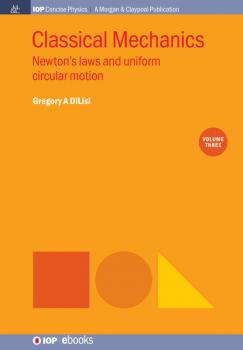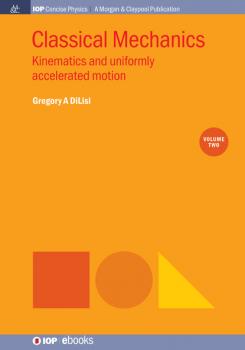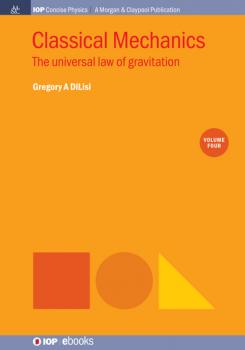ТОП просматриваемых книг сайта:
Физика
Различные книги в жанре Физика, доступные для чтения и скачиванияАннотация
Classical Mechanics teaches readers how to solve physics problems; in other words, how to put math and physics together to obtain a numerical or algebraic result and then interpret these results physically. These skills are important and will be needed in more advanced science and engineering courses. However, more important than developing problem-solving skills and physical-interpretation skills, the main purpose of this multi-volume series is to survey the basic concepts of classical mechanics and to provide the reader with a solid understanding of the foundational content knowledge of classical mechanics. Classical Mechanics: Newton's Laws and Uniform Circular Motion focuses on the question: 'Why does an object move?'. To answer that question, we turn to Isaac Newton. The hallmark of any good introductory physics series is its treatment of Newton's laws of motion. These laws are difficult concepts for most readers for a number of reasons: they have a reputation as being difficult concepts; they require the mastery of multiple sub-skills; and problems involving these laws can be cast in a variety of formats.
Аннотация
Classical Mechanics teaches readers how to solve physics problems; in other words, how to put math and physics together to obtain a numerical or algebraic result and then interpret these results physically. These skills are important and will be needed in more advanced science and engineering courses. However, more important than developing problem-solving skills and physical-interpretation skills, the main purpose of this multi-volume series is to survey the basic concepts of classical mechanics and to provide the reader with a solid understanding of the foundational content knowledge of classical mechanics. Classical Mechanics: Kinematics and Uniformly Accelerated Motion focuses on the difference between asking, 'How does an object move?' and 'Why does an object move?'. This distinction requires a paradigm shift in the mind of the reader. Therefore, the reader must train themselves to clarify, 'Am I trying to describe how the object moves or why the object moves?'.
Аннотация
Classical Mechanics teaches readers how to solve physics problems; in other words, how to put math and physics together to obtain a numerical or algebraic result and then interpret these results physically. These skills are important and will be needed in more advanced science and engineering courses. However, more important than developing problem-solving skills and physical-interpretation skills, the main purpose of this multi-volume series is to survey the basic concepts of classical mechanics and to provide the reader with a solid understanding of the foundational content knowledge of classical mechanics. Classical Mechanics: The Universal Law of Gravitation focuses on the notion that forces act through their associated fields, which is first introduced when discussing Newton's universal law of gravitation. A huge conceptual leap is required from the reader: an object can cause another object to move without even touching it. This is a difficult concept to reconcile with our everyday experiences but it makes perfect sense when we realize that is exactly how the Earth acts on us. Gravity is able to pull on us even though we are not in direct contact with the Earth. Also, the concept of super-position (and when it is applicable) is introduced. Super-position is crucial to the development of problem-solving skills so it will be illustrated in a number of example problems.
Аннотация
This book provides an introduction to the emerging field of quantum thermodynamics, with particular focus on its relation to quantum information and its implications for quantum computers and next generation quantum technologies. The text, aimed at graduate level physics students with a working knowledge of quantum mechanics and statistical physics, provides a brief overview of the development of classical thermodynamics and its quantum formulation in Chapter 1. Chapter 2 then explores typical thermodynamic settings, such as cycles and work extraction protocols, when the working material is genuinely quantum. Finally, Chapter 3 explores the thermodynamics of quantum information processing and introduces the reader to some more state of-the-art topics in this exciting and rapidly developing research field.
Аннотация
Maple is a comprehensive symbolic mathematics application which is well suited for demonstrating physical science topics and solving associated problems. Because Maple is such a rich application, it has a somewhat steep learning curve. Most existing texts concentrate on mathematics; the Maple help facility is too detailed and lacks physical science examples, many Maple-related websites are out of date giving readers information on older Maple versions. This book records the author's journey of discovery; he was familiar with SMath but not with Maple and set out to learn the more advanced application. It leads readers through the basic Maple features with physical science worked examples, giving them a firm base on which to build if more complex features interest them.
Аннотация
The effect which now bears his name, was discovered in 1958 by Rudolf Mössbauer at the Technical University of Munich. At first, this appeared to be a phenomenon related to nuclear energy levels that provided some information about excited state lifetimes and quantum properties. However, it soon became apparent that Mössbauer spectroscopy had applications in such diverse fields as general relativity, solid state physics, chemistry, materials science, biology, medical physics, archeology and art. It is the extreme sensitivity of the effect to the atomic environment around the probe atom as well as the ability to apply the technique to some interesting and important elements, most notably iron, that is responsible for the Mössbauer effect's extensive use. The present volume reviews the historical development of the Mössbauer effect, the experimental details, the basic physics of hyperfine interactions and some of the numerous applications of Mössbauer effect spectroscopy.
Аннотация
This book reviews basic electromagnetic (EM) wave theory and applies it specifically to lasers in order to give the reader not only tangible examples of how the theory is manifested in real life, but also practical knowledge about lasers, and their operation and usage. The latter can be useful for those involved with using lasers. As a short treatise on this subject matter, this book is not intended to dwell deeply into the details of EM waves nor lasers. A bibliography is provided for those who wish to explore in more depth the topics covered in this book. Rather the aim of this book is to offer a quick overview, which will allow the reader to gain a competent general understanding of EM waves and lasers.
Аннотация
He's back! The physicist returns with an entirely new compilation of questions and answers from his long-lived website where laypeople can ask questions about anything physics related. This book focuses on adjectives (practical, beautiful, surprising, cool, frivolous) instead of nouns like the first two books (atoms, photons, quanta, mechanics, relativity). The answers within 'Physics Is' are responses to people looking for answers to fascinating (and often uninformed) questions. It covers topics such as sports, electromagnetism, gravitational theory, special relativity, superheroes, videogames, and science fiction. These books are designed for laypeople and rely heavily on concepts rather than formalism. That said, they keep the physics correct and don't water down, so expert physicists will find this book and its two companion titles fun reads. They may actually recognize similar questions posed to them by friends and family. As with the first two books, 'Physics Is' ends with a chapter with questions from people who think that 'The physicist' is a psychic and from people who think they have the answers to life, the universe and everything.
A Handbook of Mathematical Methods and Problem-Solving Tools for Introductory Physics - Joshua F Whitney
IOP Concise PhysicsАннотация
This is a companion textbook for an introductory course in physics. It aims to link the theories and models that students learn in class with practical problem-solving techniques. In other words, it should address the common complaint that 'I understand the concepts but I can't do the homework or tests'. The fundamentals of introductory physics courses are addressed in simple and concise terms, with emphasis on how the fundamental concepts and equations should be used to solve physics problems.










